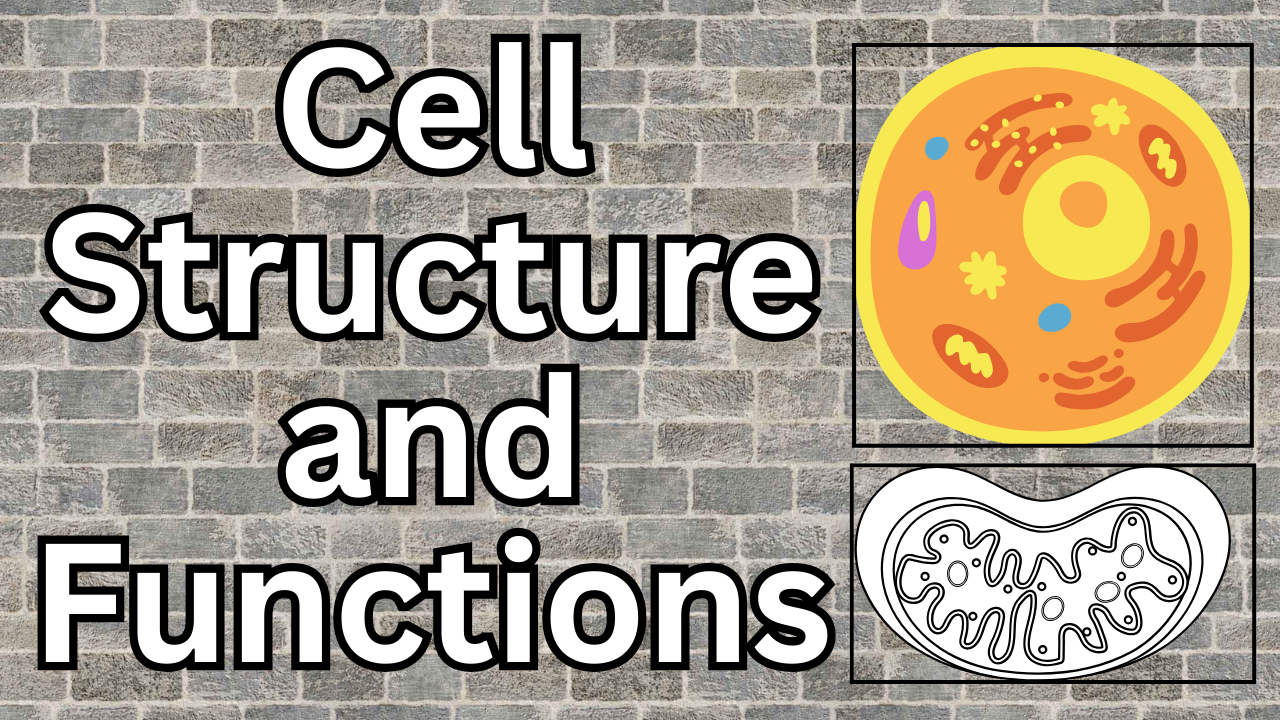Cell Structure and Function
The cell is the fundamental unit of life, serving as the building block for all living organisms. From the simplest bacteria to the most complex multicellular organisms, the cell’s intricate structure ensures the proper functioning and maintenance of life. This post delves into the detailed structure of the cell, exploring its various components, functions, and the roles they play in cellular activities.
Overview of Cell Types
Prokaryotic Cells
- Simpler and smaller in structure
- Lack a defined nucleus and membrane-bound organelles
- Examples: Bacteria, Archaea
Eukaryotic Cells
- More complex and larger
- Contain a well-defined nucleus and various membrane-bound organelles
- Examples: Plants, Animals, Fungi, Protists
The Basic Structure of a Cell
The Cell Membrane
Function and Composition
- Selective barrier separating internal and external environments
- Composed of:
- Phospholipid Bilayer: Hydrophilic heads outward, hydrophobic tails inward
- Membrane Proteins: Integral and peripheral proteins involved in transport, signaling, and recognition
The Cytoplasm
Definition and Components
- Gel-like substance within the cell membrane, excluding the nucleus
- Composed of:
- Cytosol: Semi-fluid matrix where cellular processes occur
- Organelles: Specialized structures with distinct functions
- Cytoplasmic Inclusions: Non-living substances such as pigments and granules
Key Organelles and Their Functions
The Nucleus
Structure and Function
- Control center of the cell
- Surrounded by the Nuclear Envelope:
- Double membrane with nuclear pores for molecular exchange
- Contains the Nucleolus:
- Site of ribosomal RNA (rRNA) synthesis and ribosome assembly
Mitochondria
Structure and Function
- Powerhouses of the cell, producing adenosine triphosphate (ATP)
- Composed of:
- Inner and Outer Membranes: Inner membrane folded into cristae
- Matrix: Fluid-filled space where the citric acid cycle occurs
Endoplasmic Reticulum (ER)
Smooth ER
- Lacks ribosomes
- Involved in lipid synthesis, detoxification, and carbohydrate metabolism
Rough ER
- Surface covered with ribosomes
- Involved in protein synthesis, modification, and transport
Golgi Apparatus
Structure and Function
- Stack of membrane-bound sacs
- Modifies, sorts, and packages proteins and lipids from the ER
- Packages substances into vesicles for transport
Lysosomes
Structure and Function
- Membrane-bound organelles containing digestive enzymes
- Break down macromolecules, cellular debris, and foreign substances
- Involved in autophagy (digesting damaged cell components)
Peroxisomes
Structure and Function
- Involved in lipid metabolism and detoxification
- Contain enzymes that produce and break down hydrogen peroxide
Ribosomes
Structure and Function
- Sites of protein synthesis
- Composed of ribosomal RNA (rRNA) and proteins
- Found free in cytoplasm or attached to rough ER
Cytoskeleton
Microfilaments
- Thin fibers made of actin
- Provide structural support, enable cell movement, and facilitate intracellular transport
Intermediate Filaments
- Provide mechanical strength and stability
- Help maintain cell shape and anchor organelles
Microtubules
- Hollow tubes made of tubulin
- Involved in cell division, intracellular transport, and maintaining cell shape
Centrioles and Centrosomes
Centrioles
- Cylindrical structures involved in organizing microtubules during cell division
- Found in pairs within the centrosome
Centrosome
- Microtubule-organizing center consisting of centrioles and pericentriolar material
Cellular Junctions
Tight Junctions
- Create a barrier between adjacent cells
- Prevent leakage of substances between cells
- Essential for maintaining the integrity of epithelial tissues
Desmosomes
- Adhesion structures that provide mechanical strength to tissues
- Link intermediate filaments between adjacent cells
Gap Junctions
- Allow direct exchange of ions and small molecules between adjacent cells
- Facilitate intercellular communication
Cell Cycle and Division
Interphase
- The cell grows and duplicates its DNA in preparation for division
- G1 Phase: Cell growth and preparation for DNA replication
- S Phase: DNA replication
- G2 Phase: Further growth and preparation for mitosis
Mitosis
- Process of nuclear division resulting in two genetically identical daughter cells
- Prophase: Chromosomes condense, nuclear envelope breaks down, mitotic spindle forms
- Metaphase: Chromosomes align at the cell’s equatorial plane
- Anaphase: Sister chromatids are pulled apart to opposite poles
- Telophase: Chromosomes decondense, nuclear envelope reforms
Cytokinesis
- Division of the cytoplasm following mitosis
- Results in two separate daughter cells
Cellular Adaptations
Apoptosis
- Programmed cell death to eliminate damaged or unnecessary cells
Cellular Senescence
- State where cells lose their ability to divide and function
- Associated with aging and various diseases
The structure of the cell is a marvel of biological engineering, with each component playing a crucial role in maintaining the cell’s integrity and function. Understanding the intricate details of cellular structure helps us appreciate the complexity of life and provides insights into various biological processes and diseases. As research continues to advance, our knowledge of cell biology will further expand, leading to new discoveries and applications in medicine and biotechnology.
MORE : Current Affairs – September 8 2024: Top Headlines and Updates
<<<<<<<<<<<<JOIN US>>>>>>>>>>>>>>>>
| Subscribe our PHARMACY INDIA Youtube Channel for more Pharma Updates | Click Here |
| Follow us on Instagram | Click Here |
| Download PHARMACY INDIA MOBILE APP from Google Play Store | Click Here |
| Follow us on LinkedIn | Click Here |






